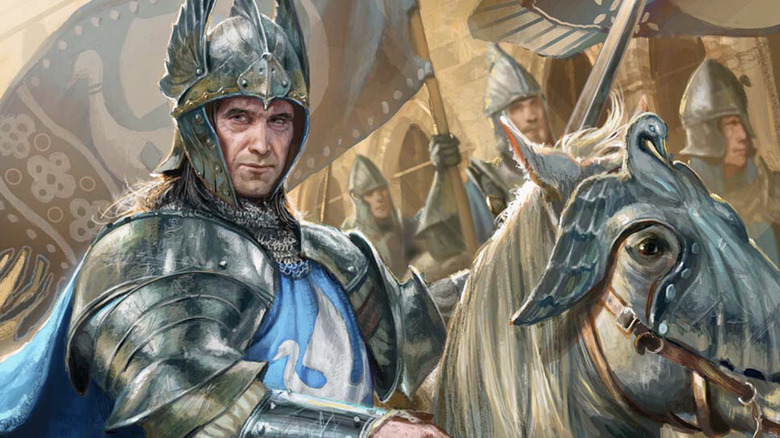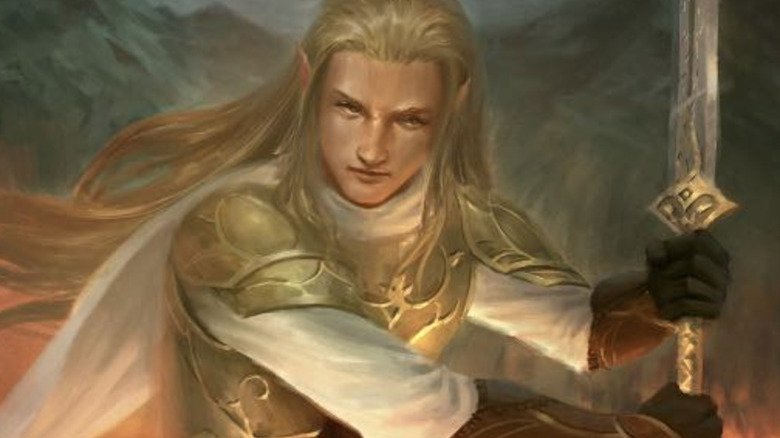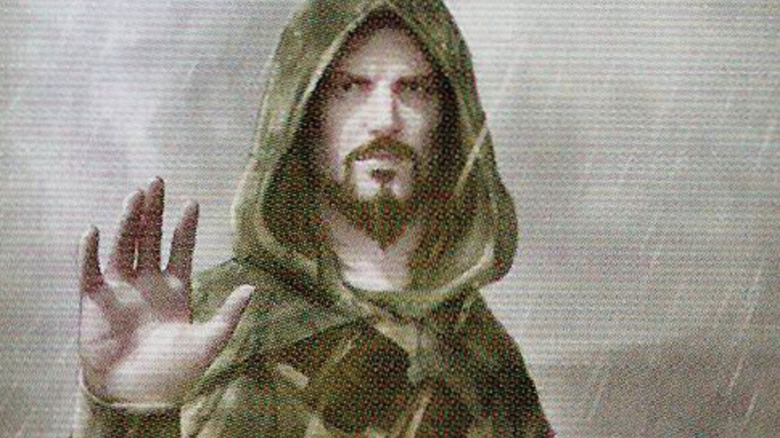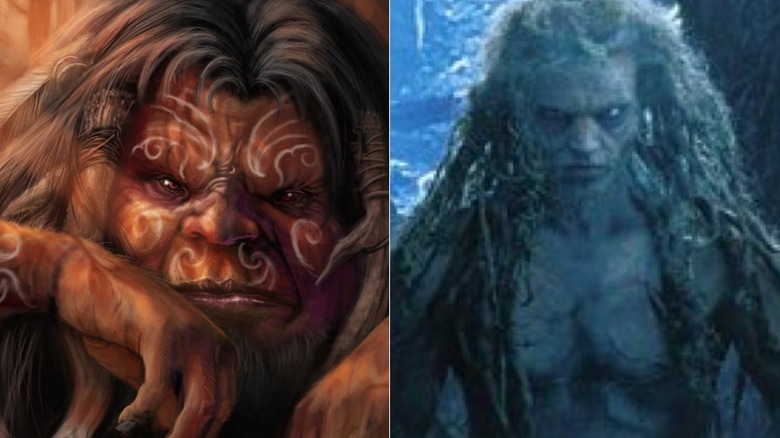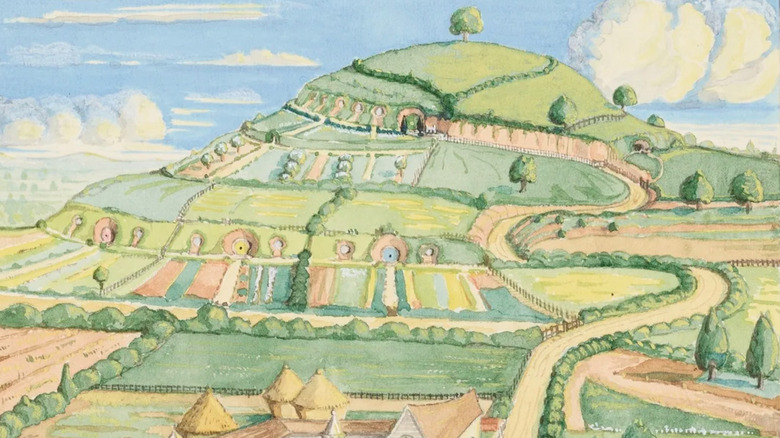The Lord Of The Rings Characters Who Didn't Make It Into The Movie
There hasn't been a motion picture trilogy quite like "The Lord of the Rings." Based upon the high fantasy epic by J.R.R. Tolkien, the film trilogy was directed by filmmaker Peter Jackson who introduced the world of Middle-earth to new audiences everywhere. However, given the extensive nature of Tolkien's original world, it soon became obvious that Jackson and company were going to have to cut down on some of the book's material in order to make a movie trilogy work. This meant that there were plenty of characters left behind by the Fellowship, who carried onto Mordor without them.
"There are lots of things in these films which are not from the books, but I think in most cases they're improvements," the late actor Christopher Lee — who boasted about reading Tolkien's epic every year — said on the Appendices for "The Fellowship of The Ring" (via YouTube). "Because there are scenes that do have to be seen, and they add a lot to it." However you feel about the loss of characters like Tom Bombdail, Glorfindel, or Ghân-buri-Ghân, it's hard to argue with someone who loves the original books as much as Lee did.
Nevertheless, if you haven't read the books and you have no idea who we could be talking about, these are the biggest characters in "The Lord of the Rings" who were tragically left out of the movies. And no, we won't even mention "The Scouring of the Shire."
Prince Imrahil
Did you know that there is a prince who helps Gandalf defend Minis Tirith when Denethor has his mental breakdown and nearly kills his son? There is: The Prince of Dol Amroth, in fact, which is a Gondorian principality to the south near the sea. The 22nd prince of the realm, Prince Imrahil, is actually an important part of "The Return of the King" — or at least what he does is important. Following Denethor's abandonment of his men, Imrahil comes to Gandalf's aid in defending the city from the invading armies of Mordor, but not before rescuing his nephew Faramir from the Southron invaders.
That's right, Imrahil is Denethor's brother-in-law, and though he tries to get Aragorn to take a leadership position in Gondor more quickly, he ends up ruling over Minas Tirith until after Aragorn sees to the healing of his people. It's also worth noting that it's Imrahil who recognizes that Éowyn is still alive after her battle with the Witch-King, and it's likely because of his urgency that she survives at all. After the War of the Ring was long over, Éomer married Imrahil's daughter Lothíriel, thus further binding Rohan and Gondor together after Faramir and Éowyn were wed.
According to the "Lord of the Rings" trading card game, Imrahil does appear in the movies, though we never hear his name. Evidently, the character played by Ian Hughes in "The Return of the King" is actually Imrahil, though it was never officially confirmed.
Tom Bombadil
If you've been on the Tolkien-related interwebs long enough, you've undoubtedly come across the blue-garbed singing creature named Tom Bombadil. First appearing in Tolkien's epic poem "The Adventures of Tom Bombadil" in 1934, the character was included in "The Lord of the Rings" two decades later, with a lot more to do this time around. In the sixth chapter of "The Fellowship of the Ring," Frodo, Sam, Merry, and Pippin make it to the Old Forest, where they're eventually saved by Bombadil. As a result, they spend two nights in his house and learn that Bombdail curiously isn't affected by the power of the Ring — nor does he care much about it.
Despite fan outcry, director Peter Jackson says that there's a practical reason for Bombadil's absence. Since his trilogy ultimately boils down to the story of Frodo taking the One Ring to Mordor, not everything from Tolkien's original epic fits neatly into that. "What does Tom Bombadil ultimately really have to do with the Ring?" Jackson asks in the Appendices to the first film. "It's not really advancing our story, it's not really telling us things we need to know."
Of course, many fans (and likely Tolkien himself) would disagree, stating that Bombadil's chapters are a vital part of Frodo's journey. Nevertheless, the strange singing man was cut from Jackson's adaptation and has yet to appear in live-action. Well, unless you count "Khraniteli," the Russian adaptation of "The Fellowship of the Ring" that included both Tom and his wife Goldberry.
Goldberry
Speaking of Goldberry, with Tom Bombadil out of the picture, it's obvious why his fair maiden of a wife would be cut as well. Like her husband, Goldberry has only ever been portrayed in live-action via "Khraniteli," with all other adaptations ignoring her completely. This is a shame, though, as "The Lord of the Rings" has so few female characters to begin with, with only Cate Blanchet's Galadriel, Miranda Otto's Éowyn, and Liv Tyler's Arwen (who hardly even appears in the novels outside the appendix) highlighted in the film trilogy.
Goldberry is the picture of perfect domestic bliss and has often been equated with the biblical Eve. In fact, many believe Tom Bombadil and Goldberry are meant to represent the purity of the Catholic sacrament of marriage. Like Bombadil, Goldberry has a unique connection with the natural world around her, especially when it comes to running water, but these mysterious abilities are never fully explained. To this day, no one really knows what Tom Bombadil and Goldberry are, though Tolkien's "The Adventures of Tom Bombdail" points to our heroine being the River-woman's daughter, which probably raises more questions than it answers.
But one thing's for sure, the hospitality that the Hobbits receive from Goldberry is unparalleled on their journey, with only Rivendell as her competition. Still, it would've been nice to see Goldberry in all her splendor on the big screen, but alas. Guess we'll have to wait for the inevitable remake.
Old Man Willow
Another character introduced during the Tom Bombadil trilogy of chapters in "The Fellowship of the Ring," Old Man Willow is the reason that the four Hobbits have to be rescued by the jolly blue-clad giant in the first place. Not to be confused with the Ents, Old Man Willow is a mean old tree whose own anger and frustration caused much of the Old Forest's own darkness. As the four Hobbits make their way through the trees, Old Man Willow puts a spell on the little folk, who fall fast asleep beneath him. In fact, the tree tries to swallow Merry and Pippin beneath the earth, claiming them as his own.
If that sounds familiar, then think back to the scene in the extended edition of Peter Jackson's "The Two Towers" where the two Hobbits are nearly engulfed by a tree in Fangorn Forest before Treebeard can save them. While not a direct adaptation of Old Man Willow, it's easy to see where the filmmakers got the original idea from. In the book, however, Frodo and Sam attempt to burn their friends out of the trunk, only for Old Man Willow to reveal that the more they burn, the further he'll drag them downward.
In the end, it's Tom Bombadil who pulls the Hobbits out before singing the old willow tree back to sleep, and given the central role of Mr. Bombadil in this encounter, it's easy to see why it was cut, or rather adapted differently.
The Barrow-wights
The final introduction during the Tom Bombdail saga is of the Barrow-wight, which isn't so much one creature but a host of them. These Wraith-like spirits are shape-shifters who thrive in the darkness, namely in the Barrow-downs just east of the Old Forest. After leaving Bombadil and Goldberry, the four Hobbits find themselves going through the Barrow-downs on their way to Bree, which isn't exactly ideal. Along the way, they pass through a thick bog that separates them, leading to their inevitable capture.
Although Sam, Pippin, and Merry all fall fast asleep, Frodo resists the temptation of the Barrow-wights and calls out for Tom Bombadil's aid. Naturally, he comes to rescue his new friends, and the Hobbits leave the Barrow-downs with brand-new blades that Tom picks up for them there, the Daggers of Westernesse that the Hobbits are seen wearing in the film trilogy. In the movie, they get these from Aragorn, but according to co-writer Philippa Boyens, the way the movie is cut implies that it's entirely possible that they still passed through this part of the map and encountered both Tom and the Barrow-wights off-screen along the way.
Admittedly, it was probably a smart move to remove the Barrow-wights from at least the theatrical cut of "The Fellowship of the Ring," and since they do make their way into Middle-earth later on via some "Lord of the Rings" trilogy-based video games, at least they weren't completely forgotten.
Glorfindel
Most folks lament the absence of Tom Bombadil when talking about the Peter Jackson trilogy, but the truest tragedy is the exclusion of Glorfindel. This guy is one of the coolest Elven warriors that J.R.R. Tolkien ever dreamed up, and it's a genuine tragedy that we haven't seen his story unfold in any capacity on screen thus far. As one of the mightiest of Elves, Glorfindel's story extends way beyond just the Third Age of Middle-earth. In fact, it begins during the First Age when he grew into an unmatched warrior, which ultimately led to his deadly battle with a Balrog (which doesn't have wings, by the way).
Though Glorfindel died in battle, he would be rewarded by the Valar for his heroism and re-embodied during the Second Age. In the Third Age, Glorfindel saves Frodo from the Black Riders, and using his new power from above, Frodo describes him as a shining figure, not unlike Moses after coming down from Mount Sinai. As a part of the Council of Elrond, Glorfindel suggests giving the One Ring to Tom Bombadil, but Gandalf reminds him that Tom, who holds no regard for the object, would likely lose it.
Of course, Glorfindel's role was replaced by Arwen in "The Fellowship of the Ring" feature film, who singlehandedly rode Frodo to Rivendell and fought off the Nazgûl. Presumably, Jackson wanted Aragorn and Arwen's romance to fill a greater role than it does in Tolkien's epic, so Glorfindel was excluded for love.
Quickbeam
Things take much longer to happen in novels than they do in feature films, so it's not uncommon for adaptations to cut out or combine plotlines and characters. The same is true for "The Lord of the Rings," which sacrifices Quickbeam due to the Ents' already slow nature when it comes to speeding the plot along. While Quickbeam may actually appear somewhere in "The Two Towers," it's never by name, nor does Treebeard ever reference him.
In the novel, Quickbeam is tasked with keeping an eye on Merry and Pippin while the Ent council debates their next move, an aside left alone in the movie. Of course, just as Treebeard's real name is Fangorn, Quickbeam is actually Bregalad, which roughly translates to "sudden tree." Living up to that name, it's Quickbeam who is the first of the Ents to want to attack Isengard and bring Saruman to justice, and it's because of his suggestion and determination that Treebeard sends him to babysit the Hobbits in the first place.
Though we don't know what became of Quickbeam after the events of "The Lord of the Rings," we can assume that like many Ents, he faithfully watches over the forestlands and searches longingly for the Entwives.
Halbarad
Not to be confused with the character from "The Lord of the Rings: The Rings of Power" who uses the name Halbrand, Halbarad is one of Aragorn's companions from the north. A Dúnadan Ranger himself, Halbarad first appears in "The Return of the King" after he receives a message from Galadriel that Aragorn may need his help. As a result, he and a number of other Rangers (and two Elves) accompany Aragorn, Legolas, and Gimli into the Paths of the Dead, but not before delivering to the soon-to-be-King a message from Arwen.
Along with his 30 men, Halbarad braves the battlefield as they arrive in the midst of the Battle of the Pelennor Fields. There, Halbarad dies, just as he predicted he would, though his sacrifice is not in vain. In the film, Aragorn, Legolas, and Gimli go to summon the Army of the Dead on their lonesome, with none of King Théoden's men or otherwise accompanying them. In fact, none of the Dúnadan Rangers — aside from Aragorn, of course — are even present in the film's version of the battle, which is sort of sad when you consider their supposed loyalty to their buddy Strider.
Though Halbarad doesn't show up in the movies, he does appear in the 2011 "The Lord of the Rings: War in the North" video game, which is supposedly set in the same timeline as the Peter Jackson films.
Ghân-buri-Ghân
A strange addition to Tolkien's saga, Ghân-buri-Ghân is one of those characters who isn't easy to forget about. The chieftain of the Woses (aka the Drúedain), Ghân-buri-Ghân appears in "The Return of the King" and helps King Théoden and his army travel through the Drúedain Forest, evading any potential Orc invaders. Described as a "wild man," Ghân-buri-Ghân's aid speaks to Théoden on a deeper level, who vows to make peace between their respective peoples following the War of the Ring.
"I'd like to have seen what Peter Jackson would have done with the character Ghân-buri-Ghân," actor Viggo Mortensen revealed to Empire Magazine in 2017. "Towards the end of Tolkien's 'The Return Of The King,' the Forest of Drúadan is given by newly-crowned Aragorn to Ghân and his people for their exclusive use, leaving it to them to decide that from then on if anyone else is to be allowed to enter it."
Like some of the other characters on this list (including Tom Bombadil), Ghân-buri-Ghân is featured in the official "The Lord of the Rings" trading card game, itself based on the movies and not the books, but that's the closest to a live-action appearance we'll get. Though there was a rumor going around that actor Wi Kuki Kaa was cast as the character for the third film, sadly, it was only ever a rumor.
Some other Hobbits, Men, and Elves
Despite all the time we spend in the Shire on the front and back ends of "The Lord of the Rings" trilogy, there are still a few Hobbits missing from the final cut. Among them is Fatty Bolger, one of Frodo's closest friends and probably the most memorable of the bunch. It's also worth noting that, while many believe that Farmer Maggot never appears in "The Fellowship of the Ring," he's actually supposed to be the Hobbit played by Cameron Rhodes when one of the Black Riders appears in Hobbiton looking for Frodo. In the book, the farmer tells the Nazgûl off, but in the movie, he understandably cowers away.
But Hobbits aren't the only ones missing in the movies. Bill Ferny, the horrible agent of Saruman who stalks the Hobbits when they're hiding out in Bree, is noticeably absent from the Peter Jackson films, and though there's presumably a "Billy Ferny" somewhere around there, he never makes himself known. Interestingly, he does appear in "Lord of the Rings" related content such as "The Fellowship of the Ring" video game, the trading card series, and "The Lord of the Rings Online," all of which tie back to the film franchise.
Lastly, Elrond's sons Elrohir and Elladan fail to appear in the feature films, which is a bit disappointing since they follow Halbarad to meet up with Aragorn. Along with Halbarad, they appear in "The Lord of the Rings: War in the North."
Radagast the Brown
Okay, you caught us, Radagast the Brown doesn't actually appear in "The Lord of the Rings" novel, but to be fair, neither does the Dark Lord Sauron himself. That's right, that odd Brown Wizard from "The Hobbit" movies is mentioned in Tolkien's magnum opus when Gandalf relates to the Council of Elrond how he got captured by the treacherous Saruman the White in the first place. According to Gandalf, Radagast was unknowingly tricked by Saruman into luring Gandalf to the White Wizard, but the Brown Wizard soon made up for it by sending the eagle Gwaihir to rescue his friend from atop the tower of Orthanc.
Yes, Radagast is the one behind the first eagle rescue in "The Lord of the Rings," though the movies don't mention him at all. Instead, Peter Jackson attempted to make up for it by giving the character (played by Sylvester McCoy) an expanded role in "The Hobbit" trilogy. Though he does appear in Tolkien's original story, it's in a much smaller capacity than in Jackson's trilogy of films, which — compared to his adaptation of "The Lord of the Rings" — plays real fast and loose with the original canon and mythology.
Admittedly, Radagast is one of the best additions to "The Hobbit" trilogy, and while it wasn't necessary to shoehorn him into "The Lord of the Rings," a passing mention may still have been nice. Who knows, maybe he'll show up on "The Rings of Power" someday?

